|
|
|
|
7000-series Gallery 2
7000 Gallery 1 | 7000 Gallery 2 | 7000 Gallery 3 7000 Gallery 4 | 7000 Gallery 5 | 7000 Gallery 6 7000 Gallery 7 | 7000 Gallery 8 | 7000 Gallery 9 |
|
|
|
|
7000-series Gallery 2
7000 Gallery 1 | 7000 Gallery 2 | 7000 Gallery 3 7000 Gallery 4 | 7000 Gallery 5 | 7000 Gallery 6 7000 Gallery 7 | 7000 Gallery 8 | 7000 Gallery 9 |
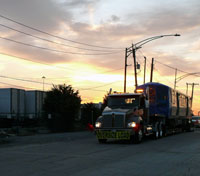 |
cta7006_20200813a.jpg (468k) Car 7006, first 7000-series car delivered to CTA, is seen at 136th and Torrence on the far Southeast Side of Chicago, leaving the CRRC railcar plant, on its way to Skokie Shop in the early morning hours of August 13, 2020. (Photo by David Harrison) |
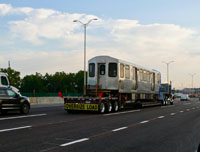 |
cta7006_20200813b.jpg (237k) A lowboy trailer carries car 7006 northbound on the Tri-State Tollway (I-294) on its way to Skokie Shop from the CRRC factory on August 13, 2020. Although only going from the far Southeast Side of Chicago to north suburban Skokie, the truck has to take a somewhat circuitous route to avoid low bridges and other clearance limitations en route. (Photo by David Harrison) |
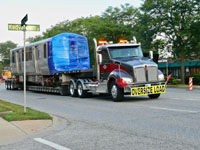 |
cta7006_20200813c.jpg (507k) Car 7006 is getting close to Skokie Shop on its trip from CRRC to CTA, passing Kedvale Avenue eastbound on Dempster Street on August 13, 2020. The blue plastic over the front end of the car helps protect the front window glass as the fiberglass end cap from dings and damage from rocks and other debris while traveling by truck, especially on the freeway at higher speeds. (Photo by David Harrison) |
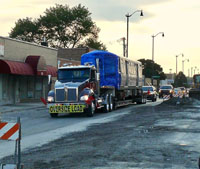 |
cta7006_20200813d.jpg (446k) The first 7000-series car has arrived at CTA -- the truck carrying car 7006 is on Oakton Street right across from the entrance to Skokie Shop on August 13, 2020. (Photo by David Harrison) |
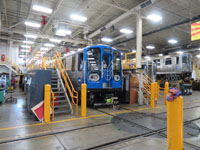 |
cta7005_20200822.jpg (243k) Car 7005, one car of the first 7000-series married-pair CTA took delivery of, sits on track I-North in Skokie Shop on August 22, 2020. Each 7000 the CTA took delivery of had to go through an inspection and testing before it was accepted, even the prototype cars. No doubt, being the very first 7000 received, cars 7005-7006 had a particularly rigorous pre-acceptance inspection. (Photo by Graham Garfield) |
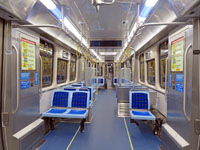 |
cta7005_20200822_int1.jpg (225k) The interior of car 7005 is seen on August 22, 2020 while it sits in Skokie Shop undergoing acceptance inspection. This view looks from the #1 and #2 side doors at the front end of the car down the aisle toward the back of the car. The 7000 seating plan is a compromise, a mix of arrangements from other car series. The middle section of the car has 1 x 2 seating like a 3200-series car, with single seats providing more standing room in the aisle but still providing transverse (front- or rear-facing) seats. The rear of the car (in the background) has 2 x 2 seating like a 2600-series car, providing more seats but less standing room. The front of the car (behind the photographer) has longitudinal (aisle-facing) seating like a 5000-series car. (Photo by Graham Garfield) |
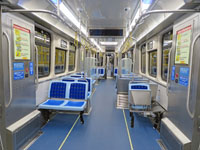 |
cta7005_20200822_int2.jpg (219k) This view of the interior of car 7005 on August 22, 2020 is the same as the photo above, but the single seat in the right foreground, facing the #2 side door, is flipped up, demonstrating that like the double-seat across the aisle it is a wheelchair position. The securement devices for a wheelchair are visible under both seats. The seats can also be flipped up during rush hour to provide more standing room, though most riders would prefer to have it down and sit, even if it means slightly less overall capacity. (Photo by Graham Garfield) |
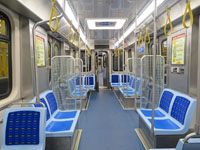 |
cta7005_20200822_int3.jpg (222k) The rear section of car 7005 is seen on August 22, 2020, looking from the middle section of the car toward the #3 and #4 side doors and the #2 (rear) end. Aside from the aisle-facing seats immediately adjacent to the doors (something present on all CTA railcar series), the rear section has 2 x 2 seating. providing more sitting room and less room for standees -- this arrangement was chosen because most passengers tend not to move into this part of the car to stand anyway, even in car series with more aisle space here. (Photo by Graham Garfield) |
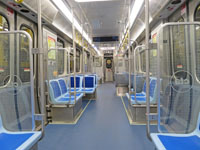 |
cta7005_20200822_int4.jpg (224k) The interior of car 7005 is seen looking toward the front end of the car from the #3 and #4 side doors on August 22, 2020. The 7000-series cars don't have "modesty panels" -- a solid, opaque panel high enough to come above the legs of someone sitting next to the door, thus providing "modesty" for that person, especially a woman wearing a skirt -- between the side doors and the adjacent aisle-facing seats the way previous railcar series did. Instead, the glass windscreens are longer and extend down to meet the seats. The idea was to eliminate the solid panel and give the car interior and more open, spacious feel, as well as to make it a somewhat less appealing place to lean and block passenger circulation through the side doors. (Photo by Graham Garfield) |
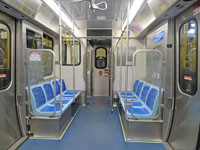 |
cta7005_20200822_int5.jpg (209k) The front end of the 7000-series cars, next to the motorcab, have longitudinal (aisle-facing) seating, like in a 5000-series car, as seen on car 7005 on August 22, 2020. The design of the windscreens next to the side doors is nearly identical to those on the Washington Metro's (coincidentally-named) 7000-series cars, built in 2012-2020 by Kawasaki Rail Car, down to the pattern on the glass, just swapping the CTA's logo for the Metro's. (Photo by Graham Garfield) |
|
|